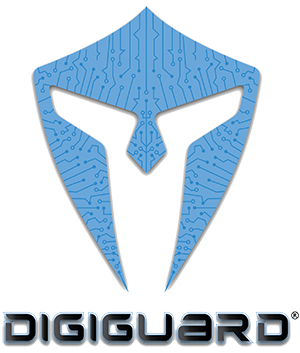Malware in Emails – Do You Have An Infected Computer?
Summary: This 3-minute article explains the types of malicious code embedded in emails and how it can be activated to infect your network and all your devices. Contact DIGIGUARD CYBER SECURITY at 833-33-CYBER (833-332-9237) or visit www.DIGIGUARDsecurity.com to schedule a cyber risk analysis and discuss the best cyber threat protection possible for your small to midsized business.
Malware or “malicious software” is an ongoing cyberthreat. Cybercriminals continue to find new vulnerabilities through which their malware may be launched. Additionally, with the recent increase in remote access work and the ever-expanding IoT (smart devices) universe, the target landscape for cyberattacks has never been greater.
Malware Email Examples
Unfortunately for the unsuspecting user, there is a variety of malware available to hackers to infect emails:
- Spyware – Spyware is just what it sounds like. A spyware attack can enable the cybercriminal to “spy” on the user’s actions on their device 24/7. By capturing and logging the user’s keystrokes, this type of malware provides hackers with access to your most private data, such as passwords, bank accounts, etc.
- Adware – Adware is one of the most common malware attacks. Adware can bombard the user’s devices with unwanted ads and by clicking on those ads, the user can be tricked into downloading more dangerous types of malware.
- Fileless Malware – Fileless Malware doesn’t directly attack files. Fileless Malware uses non-file objects such as Powershell, Microsoft Office macros and other system-related tools. Because there is no specific file infected, this type of malware can be undetected for more extended periods of time. Traditional anti-virus software can not recognize this attack as there are no infected “files.”
- Viruses – If a user impulsively clicks on a suspicious file attached to an email, it will then be launched and can infect a business’s entire system and spread to other ones. In addition, viruses can delete, move, encrypt or corrupt your business’ data.
- Computer Worms – Although worms can spread to multiple devices and systems, worms don’t infect other programs. Instead, a worm targets known exploits and software vulnerabilities before developers fix them.
- Trojans – Trojans are malicious programs disguised as legitimate ones. Once tricked into launching them, users are either directed to a malicious website or the trojan is launched into the users’ network. Trojans are harder to detect because they employ social engineering to spread.
- Ransomware – Ransomware is one of the most prominent cybercrimes of our time. Ransomware encrypts a device's data, making it impossible for the user to access. Then, as in any “kidnapping,” at ramson is demanded before the data will be unlocked. Hackers also threaten that if the ransom is not paid by a deadline, the ransom will double daily. Finally, unpaid ransoms can lead to the hacker deleting all the user’s data.
- Bots – Bots are small software programs that clandestinely perform automated functions without any interaction. What makes Bots so nefarious is that they infect multiple devices, creating a “botnet.” Once fully operational, botnets can launch massive cyberattacks.
Phishing Emails are the most popular method hackers use to steal private data and infect systems. A phishing attack can have devastating consequences for small and midsized business targets. The FBI called compromising business email https://www.fbi.gov/scams-and-safety/common-scams-and-crimes/business-email-compromise “one of the most financially damaging online crimes.”
Phishing Email Examples
- A user opens an email that appears to be from a trusted source. At first glance, the email address, domain and other visible aspects look authentic. However, the differences between genuine and phishing emails are often subtle. Perhaps the only difference in the email address is the domain name. Maybe instead of being spelled “@gmail.com,” the fake email domain is “@qmail.com.” The unsuspecting user doesn’t notice the “g” was replaced by a “q” and impulsively clicks on an embedded link that redirects them to a malicious website.
- Phishing emails often have a threatening “Important Notice” heading in the email. The body of the email demands you take specific action to keep an account from going into default. For example, the email might urgently request that the user fill out a form sharing personal information to resolve the issue. This type of email preys on fear and prompts the user to act impulsively under pressure.
Get a DIGIGUARD Cyber Risk Analysis
As your business grows, expands its network and adds more devices such as smart controls, wireless access and remote access, your network vulnerability grows, too. DIGIGUARD specializes in proactive cyber security and network security and has a wide array of solutions for small and midsized businesses to defend against cyberattacks and other network data breaches. They are cyber security experts who can ensure your confidential business and financial data has the best protection possible. Furthermore, they can establish security protocols for your employees, so they do not inadvertently open your company to a cyberattack.
Cyber Threat Protection
In addition to helping you defend against or recover from cybercrimes, DIGIGUARD can provide solutions that offer early detection of potential cyber threats before they happen. Furthermore, DIGIGUARD can assess your cyber vulnerability and work with you to ensure you have the best network and data protection solutions for your business.
Contact DIGIGUARD CYBER SECURITY at 833-33-CYBER (833-332-9237) www.DIGIGUARDsecurity.com to discuss the prevention of cyberattacks and other cyber defense protocols to protect your hard-earned business data and stay current as new and more powerful protections are developed.


